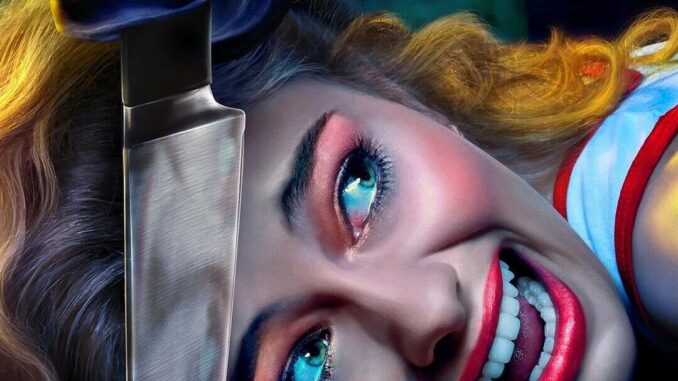
If you’re like me (choosing a Netflix subscription over regular cable) you may have missed Season 9 of American Horror Story in 2019, on its home network of FX. You also may have missed it because (sadly) you’ve heard that the murderous series just isn’t what it used to be. You wanted to save yourself the disappointment. Regardless of your reasoning, the latest season entitled 1984 was released by Netflix on Nov. 13.
The FX anthology created by Ryan Murphy and Brad Falchuck, is known (and highly respected) for its gory yet psychologically intriguing plotlines: Murder House was a spin on the classic Haunted House trope yet sported the birth of the antichrist. Asylum was your classic One-Flew-Over-the-Cuckoo’s-Nest-esque, eerily sterile, creepy mental institution, but devolved into alien invasions and Nazi doctors. Coven (my personal favorite) was about witches, yes, but sizzled with themes of feminism and race (among other social justice issues) at every unexpected turn. The following seasons followed suit when it came to intrigue.
Flash forward to the ninth season, 1984, which pays homage to 1980s slasher movies. With the infamous LA serial killer “the Night Stalker” on the loose, a band of cliché aerobics junkies decide to escape the city for the summer as camp counselors. Camp Redwood (even more infamous than the Night Stalker) was home to the most horrific mass murder of 1970. Yes, clearly one can expect the season to be campy (get it?) but based off AHS’ rich past, there’s got to be some depth, right?
While, judging from the title, one might expect the twist to be Orwellean in nature, the deep, meaningful, underlying message was … 1980s slasher movies. Yup — blood, guts, bleached hair and guys in short-shorts was where 1984 started and ended.
Much like the characters, when it came to striking a theme, the nine episodes took some poorly aimed shots. The series made an effort to speak on trauma and the difficulty of escaping it. That shot backfired however, because the character’s backstories (and in turn their traumas) were extremely weak. I (disappointedly) ended up watching the show for what it was: shock-horror, jump scares, really good ‘80s background tracks, and a lot, A LOT of Emma Roberts running frantically through the woods.
In addition to missing a solid message, the season missed its solid cast (another factor of the anthology that has made it so highly respected). While the series has been lacking Jessica Lange since season four (sigh), seasons five through eight had some pretty amazing players, regularly featuring Sarah Paulson, Evan Peters, Angela Bassett and Kathy Bates. 1984 starred Emma Roberts (also a regular from AHS’ past) as Brooke. Unfortunately, without the support of her usual team, Roberts was wildly underwhelming. Between a wobbly character arch and horrendously forced crying scenes, she left much to be desired.
The rest of Roberts’ Scooby-Doo-gone-wrong gang weren’t much better. Cody Fern (“The Tribes of Palos Verdes”) was the starving actor turned gay-for-pay porn star, Xavier. Billie Lourd (“Scream Queens”) was the “roadside Cindy Lauper” and aerobics teacher, Montana. Gus Kenworthy, who is an olympic Skier, played the Olympic-disqualified roid-enraged Chet. DeRon Horton (“Dear White People”) was the cowardly frat bro, Ray. Matthew Morison (“Glee”) was the well-endowed coke fiend, Trevor.
The spot-on and hysterical ‘80s stereotypes could not make up for the lack of sustenance in the gang’s acting. Often bolstered by special effects, the performances were always fluffed up with countless emotional outbursts and fits of rage that seemed hollow despite their volume and empty despite their tear-streaked, bloodied faces.
While Leslie Grossman (“What I Like About You”), Angelica Ross (“Pose”) and John Carroll Lynch (“Zodiac”), all gave sturdy performances throughout the nine episodes of 1984, the standout acting was done by Lily Rabe and Dylan McDermott. Unfortunately, their roles were only reserved for the last handful of episodes.
Rabe, who had larger roles in past seasons of American Horror Story, stole the season, giving a complex and heart-breaking performance as the woefully wandering, deeply disturbed and grieving ghost-mother, Lavinia Richter. McDermott, who had a large role in season one (Murder House) played Bruce, the hitchhiking serial killer. Out of all the evil serial killers in 1984 (and there were many), McDermott was easily the creepiest and most believable, arresting the screen every time he appeared.
The costumes, make-up and special effects in 1984 were stellar. Carleigh Herbert, Michael Mekash, Abby Clawson, Vincent Van Dyke, Michelle Ceglia, Analyn Cruz and Taschi Lynell were all to thank for the brilliant prosthetics and period looks that didn’t detract from the plotline. Good thing considering there wasn’t too much to detract from.
While 1984 was thrilling at times, funny at times and the music was great, it simply did not meet the American Horror Story standard. Lacking its normal depth and out-of-this-world acting, perhaps the scariest takeaway from this season was the nagging thought that “American Horror Story” should have quit while it was ahead.
